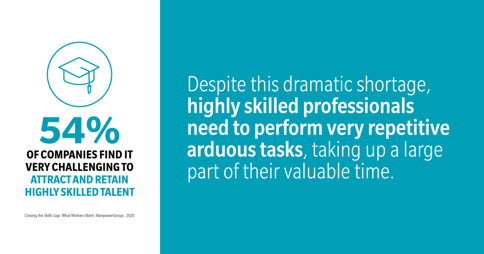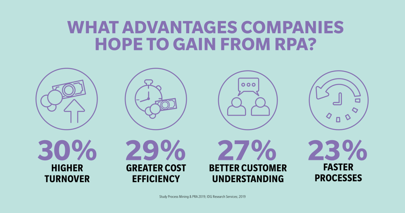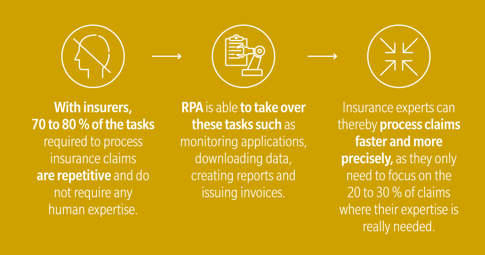Finding the right, skilled professionals that businesses need on their path to success is one of the biggest challenges companies face today. Globally, the war for talent is placing a growing burden on companies, large and small. According to one of the biggest surveys conducted by the recruiting specialist ManpowerGroup[1], 54 percent of companies find it very challenging to attract and retain highly skilled talent. This is almost twice as many as a decade ago – a record high – and an improvement is not on the horizon. Companies in 36 countries (out of 44 surveyed) state that each year it is becoming increasingly difficult to find the right people for their vacant positions. This dramatic shortage has profound implications on how processes can be set up within an organisation. More often than not, highly skilled professionals need to perform very repetitive arduous tasks, taking up a large part of their valuable time. According to Workfront research, only a mere 43 percent of a workday is spent executing primary value-adding duties.[2] Without doubt, repetitive tasks have to be done by someone – or, better, something: Robotic Process Automation (RPA) can take over many of these tasks. Imagine such tasks are processed without hindering valuable employees from creating true value for the company. They should be able to focus on fostering their creativity and optimising work processes. Robotic Process Automation can record what a user is doing and mimic this for following tasks. In this way, a robot is able to deliver excellent results even faster than before onrepetitive and non-value-adding taskswhile avoiding errors. Konica Minolta helps its customers identify the potential benefits of RPA and leverage them accordingly to drive their business.

Relieving professionals in their daily work processes
“We see that enterprises struggle to deal with processes and tasks that will not create a benefit for the business. With cost pressure increasing, so is the need for operational effectiveness and efficiency. Companies are constantly under pressure to maintain their competitive edge. Above all, this means leveraging the potential of their experts to the fullest. A highly skilled professional dealing with repetitive manual tasks is not just a waste of talent, it is a waste of time and money,” observes Marcel Cobussen, Senior Business Development Manager RPA at Konica Minolta Business Solutions Europe GmbH. This is not only suboptimal for the work processes themselves, it can also have negative effects on employee motivation. 47 percent of workers complain about digital administration efforts and 48 percent about an inappropriate use of their skills.[3]

Automation technology is evolving in such a way that its use and its benefits for companies are increasing. Robotic Process Automation, as a subset of intelligent automation, can therefore be a valuable tool for companies. The top priorities that lead decision makers to consider the implementation of RPA technology include 30-percent higher turnover, 29-percent greater cost efficiency, 27-percent better customer understanding and 23-percent faster processes.[4]

Essentially, RPA is a smart software-bot that acts according to a defined set of digital instructions. It is applicable in a variety of organisational forms and fields, such as the public sector, transportation, finance, telecommunications and insurance. RPA is particularly useful wherever large amounts of data have to be processed in an analogue fashion, multiplying the workload. With insurers, for example, 70 to 80 percent of the tasks required to process insurance claims are repetitive and do not require any human expertise. These include checks as to whether the claim is legitimate with regard to the policy or whether the person submitting the claim is already in the system. RPA is able to take over these tasks, meaning that ‘digital’ employees can perform processes like monitoring applications, downloading data, creating reports and issuing invoices. Insurance experts can thereby process claims faster and more precisely, as they only need to focus on the 20 to 30 percent of claims where their expertise is really needed. Such applications for RPA will become increasingly common, and as the technology evolves further it will be able to manage more specialised tasks.
The best approach to implementing RPA
Konica Minolta has an established process to identify and implement IT solutions for its customers. As with all of its projects, the crucial first step for Konica Minolta is a thorough analysis – to understand the customer’s exact challenges and needs. For this, Konica Minolta uses dedicated process discovery technology to map pain points and processes. The results come in within hours. Then, Konica Minolta’s experts work with the customer to find out what it is that they aim to achieve. This leads to a recommendation report for a delivery roadmap and an execution plan.

A typical first step in this execution plan is digitising paper-based or analogue information to enable the automation of information flows. This eliminates transcription errors, reduces security issues and improves audit trails about information access. This digitisation creates the basis needed for the later intelligent automation of the information flow as a subsequent step. For this information automation and to drive efficiencies as well as make ‘24/7’ run times possible, Konica Minolta works with several leading independent software vendors such as Kofax, ABBYY, Hyland and M-Files. This allows Konica Minolta to offer its customers exactly the right-sized solutions for all their needs. This can include various tasks such as data capture and integration, data search and analysis, conversion and classification, storage and archive retrieval, workflow, publishing and data migration etc.
Once the flow of information is automated, the related decision-making can also follow. This is called ‘intelligent automation’. Here, intelligent robots can be deployed to use human-like intelligence to perform more complex, yet repetitive tasks. It is in this stage that the main benefits of RPA materialise: improvements in customer experience through fewer errors and shorter response times, unlocking workforce potential through relieving employees, boosting productivity through less wasted organisation time, increased agility through very rapid deployment of new services.
Finally, Konica Minolta integrates all RPA capabilities seamlessly into its holistic IT service approach. By protecting, maintaining and improving a company’s IT environment, the ultimate goal is to take away the pain in daily work and empower efficient business processes.
‘Real-life’ process robots in action
There are already a broad range of examples where companies benefit from RPA implementation in their business. A distributor of electronic components handling over one million products wanted its product management teams to shift their work away from the hundreds of manually created, time-consuming custom proposals and quotes they had to produce every week. Robots were deployed for each supplier, reducing manual effort by three minutes for each order. This also freed the product asset specialists, enabling them to advise clients on components options and truly develop a customer relationship. A large logistics & transportation company was losing business as it was unable to track where their own trucks were. It had no visibility as to whether an item had been delivered or not. With nearly 400 robots deployed, more than one million executions are performed yearly, automating 16,000 hours of work. Furthermore, 50 percent of deadlines are now completely automated, with no need for human intervention.
An insurance company has to process more than two million contracts and thousands of claims each year. It wanted to eliminate any sticking-points in the customer journey that could cause contract or claims requests to be delayed. The insurer set out to automate the contract and claims submission process. In this way they are able to reduce the number of times a single document is handled by an employee. What used to take up to two hours a day is now done in 10 to 15 minutes. Fiserv used to capture interest rates and bank balances across 300 different bank websites. This was conducted on a weekly basis, as it was too time-consuming to do it more often. From the moment robots were deployed, the required data has been captured via an automatic login three times a day, providing real-time, daily access.
The age of robots is now – supporting organisations and their employees
“RPA can significantly benefit every business – creating a meaningful impact on a company’s performance, employee satisfaction and the customer experience. When a defined set of tasks can be handed over to a robot that won’t make any mistakes or ask questions, everyone wins,” concludes Marcel Cobussen. Having an experienced provider at hand facilitates the process and adoption of RPA. Building on more than a century of experience in constantly disrupting and innovating, Konica Minolta tailors the solution perfectly for every customer. As a specialist for digital workplaces, Konica Minolta further empowers its customers with the expertise to set up robots by themselves in the future.
[1] Closing the Skills Gap: What Workers Want; ManpowerGroup; 2020; https://go.manpowergroup.com/hubfs/MPG_WhatWorkersWant_2020.pdf?hsLang=en
[2] State of Work 2020; workfront; 2019; https://www.workfront.com/sites/default/files/resource/file_pdf/2019-09/sow-report-2020.pdf
[3] World’s ‘Most Hated’ Office Tasks; Automation Anywhere/ OnePoll; 2020; https://www.automationanywhere.com/company/press-room/global-research-reveals-world-s-most-hated-office-tasks
[4] Study Process Mining & PRA 2019; IDG Research Services; 2019; https://www.reply.com/SiteAssets/Images/IDG-Studie-Process-Mining-RPA-2019.pdf



